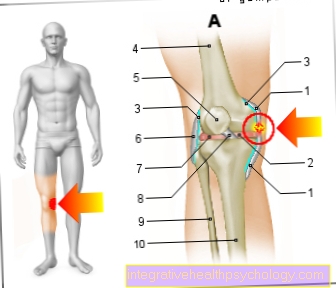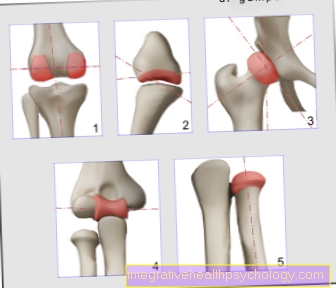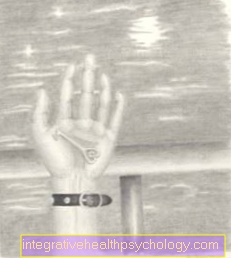Blind spot
definition
A blind spot is the area in the visual field of each eye where there are no sensory cells that can receive light. This is a naturally occurring visual field loss (Scotoma) - an area in which we are blind.

Construction of the blind spot
Anatomically, the blind spot corresponds to the optic nerve papilla (Optic papilla) where the optic nerve leaves the eye. Due to the development of the eye, the dissipative fibers of each light-sensitive sensory cell are located further in the center of the eye than the sensory cells themselves. In addition to a slight deterioration in the resolving power of our eye, this leads to the problem that the fibers, when they leave the eye, the layer of the sensory cells have to pierce. This takes place in the optic nerve papilla, which therefore cannot contain any sensory cells and is also not sensitive to light.
The blind spot is shifted 15 ° towards the nose in the visual field of each eye. Due to the refraction of light by the lens of the eye, the area in the field of view is 15 ° outside the center of the visual axis on each side. The fact that the healthy person is not aware of the lack of visual information at this point is due to the excellent performance of our brain, from the surrounding areas, the information from the other eye and by calculating different images from different eye movements towards the image in the blind spot conclude.
How big is the blind spot?
The blind spot has a diameter of approx. 1.6-1.7 mm. This is a passage point (papilla), through which both the nerve fibers and the associated blood vessels leave the eyeball. It is kept as small as possible by the body, but must also be large enough for the number of fibers passing through. If it is too small, it would squeeze the vessels and the eye could be damaged. The size mentioned above denotes an average value, which in individual cases may also vary slightly up or down.
What is the function of the blind spot?
The physiological exit point of the optic nerve from the eyeball is called the blind spot. This point itself has no function. Here the nerve fibers of the optic nerve leave (Optic nerve) as a bundle the eye on the way to the brain. There are no visual cells, so-called "photoreceptors", at this point. As a result, no visual performance can be recorded here either and the person cannot see anything there.
The body keeps the blind spot as small as possible in order to create the least possible loss of field of view. However, it also has to be large enough to pass the nerve and blood vessels on without being crushed. The loss of the visual field is compensated for by optical impressions of the other eye in the brain so that the blank space is not noticeable. The brain can compensate for the missing point and thus ensures that everyone can naturally perceive an overall picture of the environment.
Figure blind spot

- Cornea - Cornea
- Dermis - Sclera
- Iris - iris
- Radiation body - Corpus ciliary
- Choroid - Choroid
- Retina - retina
- Anterior chamber of the eye -
Camera anterior - Chamber angle -
Angulus irodocomealis - Posterior chamber of the eye -
Camera posterior - Eye lens - Lens
- Vitreous - Corpus vitreum
- Yellow spot - Macula lutea
- Blind spot -
Discus nervi optici - Optic nerve (2nd cranial nerve) -
Optic nerve - line of sight - Axis opticus
- Axis of the eyeball - Axis bulbi
- Lateral rectus eye muscle -
Lateral rectus muscle - Inner rectus eye muscle -
Medial rectus muscle
You can find an overview of all Dr-Gumpert images at: medical illustrations
What tests are there for the blind spot?
The blind spot is usually not perceived by a compensatory reaction of the body in everyday life. However, it can be made visible through a simple test. To do this, an X and an O are written on a piece of white paper about 10 cm apart. If you cover your right eye and fix the right letter about 30cm away, the left letter disappears. When you close your left eye, the right letter disappears.
What is the difference between blind spot and yellow spot?
The yellow spot is also called the macula lutea. This is a special area on the retina through which the visual axis runs. The visual axis means that the point with the greatest density of cones, the color-sensitive sensory cells, is located at this point. When fixing an object with the eye, the eye bundles incident light rays automatically so that they hit the exact spot of the yellow spot. This means that this point is also responsible for focusing the surroundings. The size is about 3-5 mm. It is called the yellow spot because it appears yellow when the fundus is reflected. The color is created by the embedded pigments (Lutein).
In the blind spot, a piece of the retina is practically missing, which means that no visual performance is provided here, so it is exactly the counterpart to the yellow spot, where the visual center with the point of sharpest vision is located and the finest spatial perception takes place.
Read more on this topic at: Yellow spot
history
The blind spot was discovered in 1660 by the French physicist and clergyman Edme Mariotte.





























